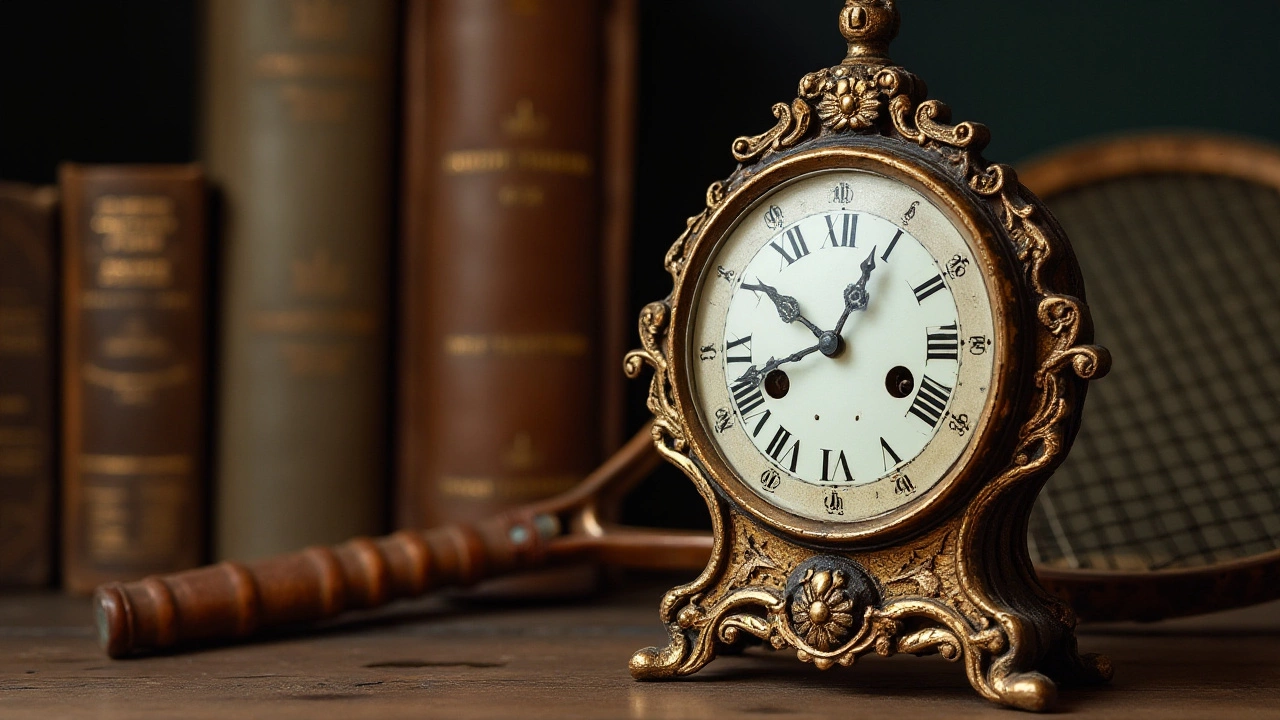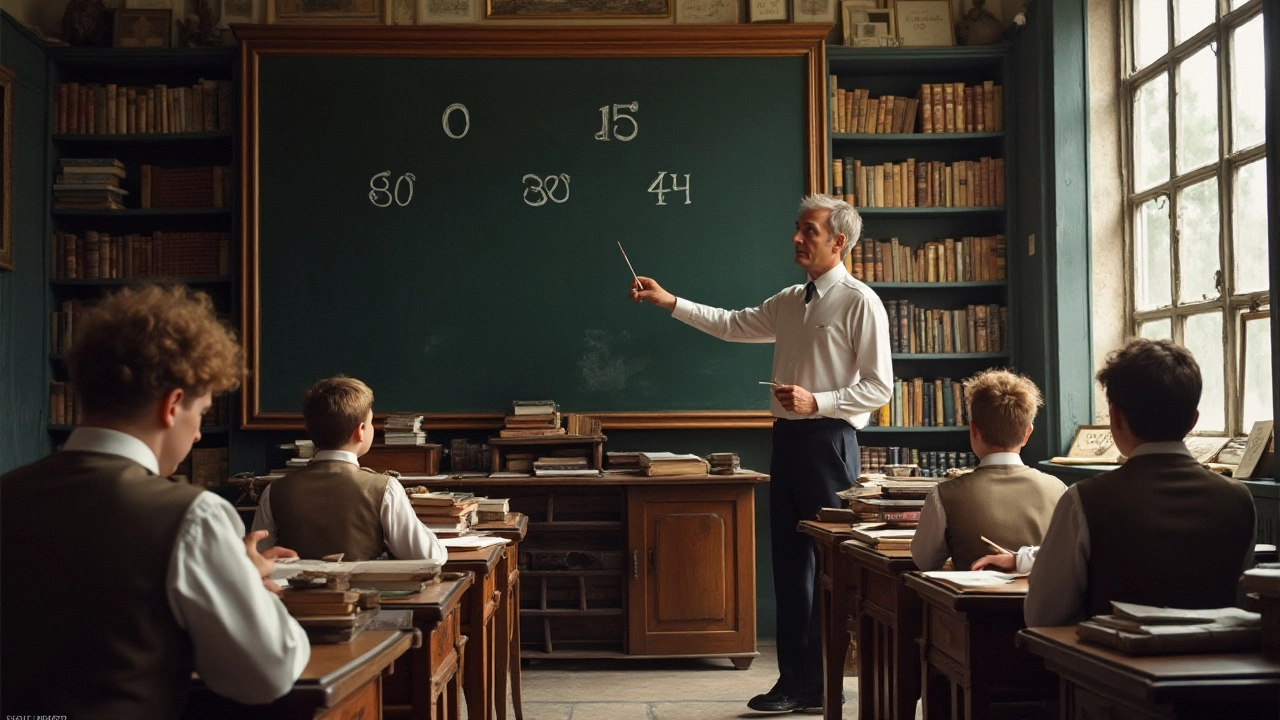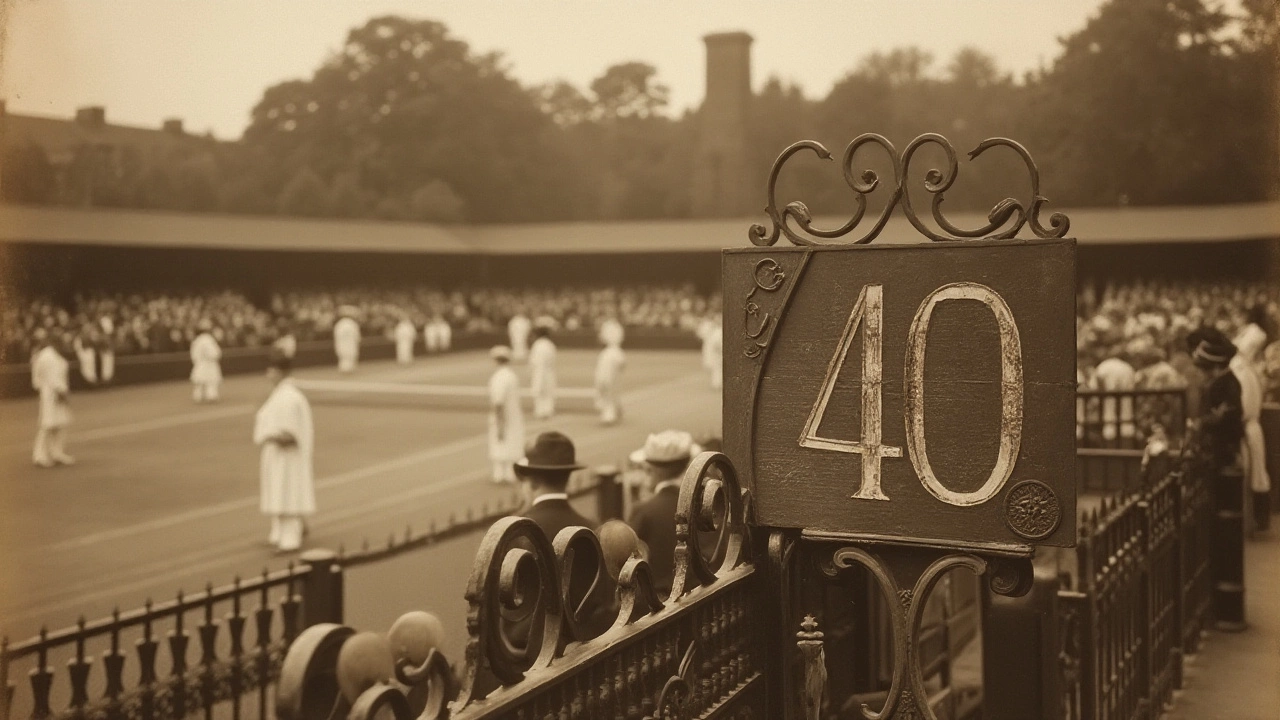Tennis is a game woven with history rich in tradition and curious peculiarities, none more intriguing than its distinctive scoring system. Have you ever paused to ponder why, in a game grounded in precision and control, the scoring leaps from 30 to 40 instead of following a more intuitive path like 45?
You're not alone in wondering this, and the answer is as intricate and fascinating as the sport itself. To understand this anomaly, we need to travel back in time, delving into the history of tennis and the various conjectures that try to make sense of this numerical oddity.
In this article, we'll embark on an exploration of tennis's enigmatic scoring. We'll unravel not only the potential origins of this system but also how it's influenced the way tennis is played today. You'll gain insights into the game's unique character, shaped by centuries of cultural evolution and sporting innovation.
- The Origins of Tennis Scoring
- Theories Behind the Number 40
- Cultural Influences on Scoring
- Comparison with Other Sports
- The Impact on Modern Tennis
The Origins of Tennis Scoring
The scoring system in tennis is as unique as it is perplexing, a relic from a distant past that has stubbornly persisted into the modern game. Tracing back to the medieval era, the roots of this peculiar method are deeply interwoven with history, tradition, and perhaps a touch of whimsy. The evolution of tennis scoring reflects a convergence of time periods and cultural practices that offer a glimpse into the game's storied past. Originally, tennis, or jeu de paume as it was known in French, was played in the courts of nobles, a pastime for the elite. Fascinatingly, the scoring terminology echoes the French heritage with terms like "love" which is thought to stem from "l'oeuf," meaning "egg," symbolizing zero points. This connection hints at the historical tapestry from which the modern game emerged.
Delving deeper into scoring, the choice of increments—15, 30, and finally 40—might seem random. Yet, one theory suggests the influence of timekeeping methods used during the game's early days. A minute hand moving around a clock face offered a convenient way to keep score, marking positions at 15, 30, and 45 minutes past the hour. However, 40 replaced 45 for reasons less documented but speculated to provide a margin for calling deuce, catering to the competitive and unpredictable nature of the game. It remains a captivating aspect of tennis, prompting enthusiasts and experts alike to engage in spirited debates. Historically, this unconventional scoring has never lacked its charms, possibly explained by a mix of practicality and the quirky customs of tennis's noble patrons. In a sport where subtlety meets complexity, these increments imbue matches with tension and strategy, elements that keep fans on edge.
"The enchanting mystery of tennis scoring is not a mathematical puzzle to solve, but a historic tradition to cherish," reflects renowned historian Dr. Marie Collins, capturing the sentiment that surrounds this age-old enigma.
Considering set lengths, the advent of game points such as 40 instead of 45 allowed matches to conclude more expediently without compromising competitiveness. Each subsequent change was adapted over time to enhance the viewer’s experience and maintain the integrity of the sport. This unwritten understanding among players and spectators alike—they engage in a delicate dance dictated by numbers that both fascinate and frustrate. The origins of tennis scoring, therefore, are steeped in illustrious tradition, revealing much about how historical circumstance can leave an indelible mark on professional sports.
Theories Behind the Number 40
The convoluted tennis scoring system not only puzzles newcomers but also invites linguists, historians, and sports enthusiasts to venture into its shadowy past. One popular theory revolves around the medieval French game of “jeu de paume,” a predecessor to modern tennis, played in grand halls where the clocked-based scoring might have found its origins. The hands of a clock were used to represent scores, incrementing by quarters - 15, 30, 45 - until the concluding 'game' point was signaled by a full circle. But somewhere along the way, the 45 was abridged to 40. This change has been speculated as an adjustment for expediency in rapid matches or perhaps to avoid confusion amidst continuous play. This interpretation remains mostly speculation, lacking undeniable historical documentation, yet tracing back this peculiar scoring to a clock face is fascinating.
"The exact origins of tennis scoring remain shrouded in mystery, but its complexity truly reflects the game's rich history," noted tennis historian Elizabeth Wilson.
Another compelling hypothesis suggests a connection to simpler probabilities and arithmetic. Tennis players might have modified the scoring to 40 as a strategic simplification when devising handicaps. This less complex non-multiplicative sum bears a logic understood easily and implemented effortlessly on the court without extensive calculations. In the fervor of competition, simplifying intricate scoring systems awarded players sharper focus on the game rather than arithmetic gymnastics, contributing to the appeal and longevity of a sport based heavily on skill and mental acuity.
Delving deeper into psychology unveils an intriguing perspective: the famed number 40 might not be about arithmetic but about pacing—the rhythm in which the game unfolds. By shortening the verbalization of the score from '45' to '40', players could more seamlessly indicate the lead-up to the game-winning point, heightening the charged anticipation inherent in the threshold of victory. This subtle shorthand not only punctuated the excitement of scoring but enriched the storied narratives conjured on every court throughout the tennis world.
Additionally, cultural inputs cannot be overlooked. The encoding of the score into '40' rather than '45' could very well have been influenced by French or English linguistic traditions, where the affection for succinctness has longstanding roots. As tennis evolved and migrated geographically, such linguistic choices may have turned conventional, much like adopting a word from a region's dialect over time.
As enchanting as the mystery surrounding the number ‘40’ is, tennis remains one of the few sports where history and improvement manifest ably through these quaint scoring conventions. As players lunge for lobs and strategize under outstretched skies, the legacy of such traditions breathes vibrance into every rally. The allure of understanding this unique scoring system's origins, while constantly intriguing, is bound to forever be part of tennis's intriguing character.

Cultural Influences on Scoring
The curious tennis scoring system, particularly the leap from 30 to 40, is a fascinating peek into how cultural shifts and historical nuances have shaped the sport. Around the 16th century, when tennis evolved from jeu de paume, the use of clocks was prevalent in Western Europe. Some theories suggest that the 60-point face of a clock was the model for early scoring—with 15, 30, and 45 being the markers used to represent quarters, similar to how an hour is broken into quarters. Over time, the 45 dropped to 40 for ease of calling scores on court, ensuring the game maintained its rhythm without too much mathematical complexity.
Beyond timekeeping influences, tennis scoring was undoubtedly impacted by the French and their love for elegance and entertainment in sports. The French contributed significantly to tennis culture, with intricate court designs and flamboyant styles of play. It's been said that nobility and aristocracy would compete not just in skill, but in who could create more impressive tennis galas on their estates. This desire for spectacle may have played into how matches were gamified, relying on peculiar and memorable scorekeeping methods to enhance the prestige and drama of each match. Similarly, the term "love" for a score of zero might stem from the French word "l'oeuf," meaning egg, symbolizing nothing.
Linguistic Borrowings and Evolution
The language of tennis itself holds clues to cultural exchanges over centuries. The French roots are undeniable, with terms like "deuce" derived from "deux," suggesting a tie. English, which became the lingua franca of the sporting world, also adapted French terminology over time, merging local and borrowed elements to create a scoring language that's as much cultural artifact as functional tool. These layers of linguistic borrowing symbolize the globalisation of tennis, as it spread from European courts to become the beloved worldwide sport it is today."The game's vocabulary reveals not only its French heritage but a broader narrative of cultural borrowing," notes tennis historian Elizabeth Wilson, highlighting how vocabulary shapes our engagement with tradition and modernity.
Modern tennis has retained these historic touches, a testament to the resilient allure of tradition in sports. Although streamlined technology aims to make umpiring and scoring more transparent, no one advocates for ditching the enigmatic scoring system. Players, new and seasoned, come to embrace this anomaly, resonant with the voices of history. Like chess with its knights and queens, tennis remains a game where understanding the arcane is part of its formidable charm.
Comparison with Other Sports
Understanding the tennis scoring system becomes more fascinating when we juxtapose it with the scoring mechanisms used in other sports. In many sports, the scoring is straightforward and linear, progressing predictably as players accumulate points. Think of basketball, where a basket counts for either two or three points, or soccer, where each goal represents a single point on the scoreboard. Yet tennis takes an eccentric detour with its unique 15-30-40 progression. The deviation intrigue lies not just in its numbers but also in the impact it has on the pace and strategy of the game.
Why does tennis charm us with its arcane system while sports like boxing and soccer, steeped in their own historical traditions, manage without such quirks? One hypothesis revolves around the games' evolution. In boxing, rounds are tightly linked to the number of punches and the stamina of the athletes, with a round system that modern audiences easily digest. Soccer keeps score simply, favoring global accessibility as rapidly spreading sports required a framework that was easy to learn and equally easy to communicate. Each goal in soccer doesn't simply tally up like counting sheep; it resonates through the game, altering strategies and sparking passion among fans.
Yet, when you analyze tennis alongside a game like rugby, we find parallels in complexity even though their roots diverge dramatically. Rugby, much like tennis, embarks on scoring adventures with varied point increments ranging from tries to conversions and penalties. Here, much of the complexity reflects the multifaceted play styles inherent in the sport. For tennis, every point isn't just a step toward winning; it's a psychological battle contained within a meticulous scoring narrative. The curiously numbered progression fosters dramatic tension and is instrumental in shaping the flow of the match. It's a far cry from the straightforward counting in baseball or the unyielding march of points on a football field.
A journey through history reveals developing sports often tailored their scoring systems to suite players’ needs or enhance certain competitive aspects. Did you know, for instance, that volleyball allows teams only to score on their serve — a rule like that shows us how games adapt to magnify particular skills? Tennis differs again by blending its historic roots with the modern vibrancy of professional tournaments, preserving its scoring count as a canvas for players to exhibit sheer mental tenacity as much as physical prowess. Legendary players have reflected on how the scoring in tennis tests not just skill but also temperance.
"Tennis isn't just about hitting a ball; it's about maintaining your nerve when the score starts to show its complexities," noted Billie Jean King.

The Impact on Modern Tennis
In the fast-paced world of modern tennis, the scoring system, with its unique progression of points, continues to influence how games are played and viewed. The jump from 30 to 40 confounds newcomers and seasoned fans alike, but this quirky numerical leap plays a crucial role in match dynamics and strategy. Players must remain acutely aware of the scoring at all times, as a single point can dramatically swing momentum. This awareness skews the game towards mental fortitude and resilience, making tennis as much about psychological endurance as physical prowess.
One of the remarkable aspects of tennis scoring is its ability to keep the audience engaged. The unconventional progression keeps the outcome unpredictable, especially during tight matches. It's not uncommon to see players overcome daunting deficits, thanks to advantages inherent in the scoring method. This unpredictable nature ensures that fans remain on the edge of their seats. The phrase "It's not over until it's over," could not be more relevant, as multiple deuce situations and break-point saves create a roller coaster ride of emotions.
Historically, the innovation of tie-breaks in the late 1960s was a direct response to the increasing length of matches, heavily influenced by the original system. Prominent tennis promoter Jack Kramer once stated,
"The essence of competitive sports is about ensuring every point has meaning. The tie-break system was born from this need, giving matches a definitive climax."Today, players must balance aggression with caution during these crucial junctures, making strategy during tie-breaks an art form in itself. Athletes train specifically for these scenarios, knowing they can be match-deciders.
As technology advances, the role of scoring in tennis evolves as well. Instant replay systems and electronic line-calling, such as Hawkeye, are now integral to maintaining the integrity of the sport. Though these systems do not alter the basic scoring progression, they ensure fair play, aligning the sport's storied past with a future of technical precision. Even with these changes, the core essence of tennis remains unchanged, held together by a scoring tradition that dates back hundreds of years.
Given its significance, coaching often focuses intensely on managing the mental toughness required by the scoring structure. Players are trained to anticipate and prepare for how different scoring situations affect opponent strategies, keeping one eye on the scoreboard and the other on their adversary. The lessons drawn from this approach extend beyond the court, teaching valuable life skills including adaptability and tenacity.
Modern tennis reflects a sophisticated blend of tradition and innovation, with its scoring system serving as a cornerstone. Whether celebrated with reverence or debated with curiosity, there's no denying the profound influence this numeric quirk has on the game. By holding onto its legacy, tennis maintains a unique appeal, ensuring it remains one of the most beloved sports worldwide.
